Maytag MAV-39 User Manual

Maytag® HE Clothes Washer |
MAV-39 |
®
USER’S
Congratulations on
your purchase of a Maytag clothes washer! Your satisfaction is very important to us.
Read this manual for best results. It contains instructions to acquaint you with proper operating and maintenance procedures.
In addition you will find a Laundering Tips guide packed with your clothes washer. It contains information on recommended laundering procedures, stain removal and special laundering situations.
Save time and money. If something should go wrong, we suggest consulting the “Before You Call” section. It is designed to help you solve basic problems before consulting a servicer.
If you have questions, write us (include your model and serial numbers and your phone number) or call:
Maytag ServicesSM
Attn: CAIR® Center P.O. Box 2370
Cleveland, TN 37320-2370 1-800-688-9900 USA 1-800-688-2002 CANADA
1-800-688-2080 USA TTY (for deaf, hearing impaired, or speech impaired)
(Mon.–Fri., 8am–8pm Eastern Time) Internet: http://www.maytag.com
GUIDE
Table of Contents
Safety instructions . . . . . . . . . . . . . . . . 1 Operating tips . . . . . . . . . . . . . . . . . . . . 2 Controls at a glance . . . . . . . . . . . . . . 3-6 Special features . . . . . . . . . . . . . . . . . . . 7 Care and cleaning . . . . . . . . . . . . . . . . . 8 Storing the washer . . . . . . . . . . . . . . . . 8 Before you call . . . . . . . . . . . . . . . . . 9-10 Warranty . . . . . . . . . . . . . . . . . . . . . . . 11 Guide de l’utilisateur . . . . . . . . . . . . . . 12 Guía del usuario. . . . . . . . . . . . . . . . . . 24
Form No. E/03/04 |
Part No. 6 2620660 |
MCS Part No. 22003949 |
©2004 Maytag Appliances Sales Co. |
|
|
|
|

Important Safety Instructions
WARNING: To reduce the risk of fire, explosion, electric shock, property damage or injury to persons when using the appliance, follow basic safety precautions, including the following:
1.Read all instructions before using the appliance.
2.As with any equipment using electricity and having moving parts, there are potential hazards. To use this appliance safely, the operator should become familiar with the instructions for operation of the appliance and always exercise care when using it.
3.Do not install or store this appliance where it will be exposed to the weather.
4.Install and level washer on a floor that can support the weight.
5.This appliance must be properly grounded. Never plug the appliance cord into a receptacle which is not grounded adequately and in accordance with local and national codes. See installation instructions for grounding this appliance.
6.To avoid the possibility of fire or explosion:
a.Do not wash items that have been previously cleaned in, washed in, soaked in, or spotted with gasoline, dry-cleaning solvents, other flammable or explosive substances as they give off vapors that could ignite or explode. Hand wash and line dry any items containing these substances.
Any material on which you have used a cleaning solvent, or which is saturated with flammable liquids or solids, should not be placed in the washer until all traces of these liquids or solids and their fumes have been removed.
These items include acetone, denatured alcohol, gasoline, kerosene, some liquid household cleaners, some spot removers, turpentine, waxes and wax removers.
b.Do not add gasoline, dry-cleaning solvents, or other flammable or explosive substances to the wash water. These substances give off vapors that could ignite or explode.
c.Under certain conditions, hydrogen gas may be produced in a hot water system that has not been used for 2 weeks or more. HYDROGEN GAS IS EXPLOSIVE. If the hot water system has not been used for such a period, before using a washing machine or combination washer-dryer, turn on all hot water faucets and let the water flow from each for several minutes. This will release any accumulated hydrogen gas. As the gas is flammable, do not smoke or use an open flame during this time.
7.Do not reach into the appliance if the tub or agitator is moving.
8.Do not allow children or pets to play on, in, or in front of the appliance. Close supervision is necessary when the appliance is used near children and pets.
9.Do not tamper with controls.
10.Do not repair or replace any part of the appliance or attempt any servicing unless specifically recommended
in published user-repair instructions that you understand and have the skills to carry out.
11.Unplug power supply cord before attempting to service your washer.
12.The agitator should not be removed. If the agitator is removed, it must be replaced by pushing down completely and the locking screw tightened before the washer is operated.
13.Store laundry aids and other material in a cool, dry place where children cannot reach them.
14.Do not wash or dry items that are soiled with vegetable or cooking oil. These items may contain some oil after laundering. Due to the remaining oil, the fabric may smoke or catch fire by itself.
15.Do not use chlorine bleach and ammonia or acids (such as vinegar or rust remover) in the same wash. Hazardous fumes can form.
16.Do not machine wash fiberglass materials. Small particles can stick to fabrics washed in following loads and cause skin irritation.
17.Before the appliance is removed from service or discarded, remove the door to the washing compartment.
18.Inlet hoses are subject to damage and deterioration over time. Check the hoses periodically for bulges, kinks, cuts, wear or leaks and replace them every five years.
What you need to know about safety instructions
Warning and Important Safety Instructions appearing in this manual are not meant to cover all possible conditions and situations that may occur. Common sense, caution, and care must be exercised when installing, maintaining or operating appliance.
Always contact your dealer, distributor, service agent, or manufacturer about problems or conditions you do not understand.
Recognize safety symbols, words, labels
 WARNING
WARNING
WARNING – Hazards or unsafe practices which COULD result in severe personal injury or death.
 CAUTION
CAUTION
CAUTION – Hazards or unsafe practices which COULD result in minor personal injury.
SAVE THESE INSTRUCTIONS
1
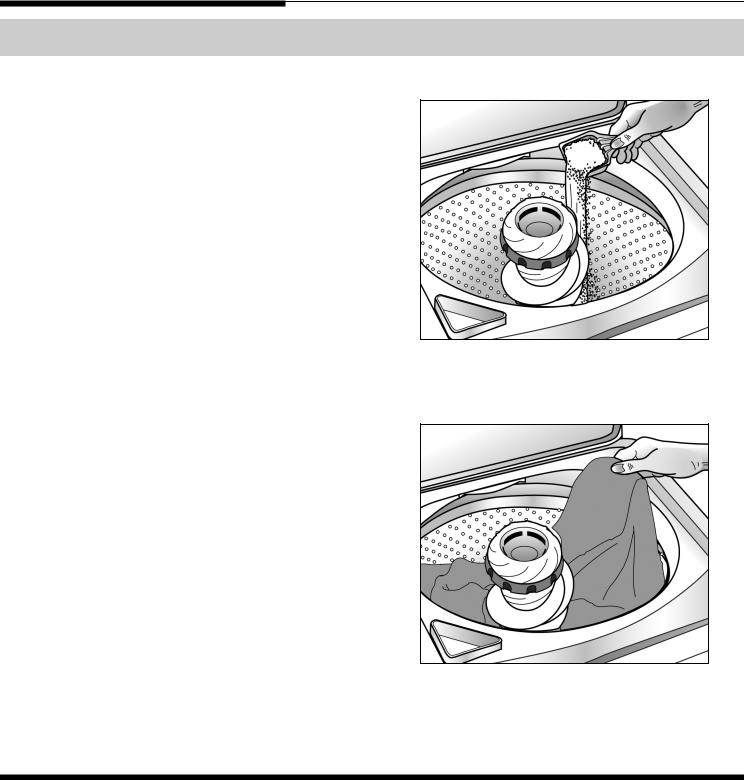
Operating Tips
For detailed information on sorting, pretreating stains, etc., see the enclosed Laundering Tips pamphlet.
Detergent
•Use either liquid or granular laundry detergent. For best results, be sure detergent is added to the washer BEFORE the load and be sure the wash water is above 60° F.
•Use the correct amount of detergent for the load size, soil level and water conditions. Use more detergent if you have hard water and very soiled loads.
If you have soft water or a lightly soiled load, use less detergent. (See manufacturer’s instructions.)
•Wipe up any detergent spills on the washer.
Loading
•Put dry, unfolded clothes loosely in the tub, up to the top row of holes for a maximum load.
•Do not wrap large items like sheets around the agitator.
•Mix large and small items for best circulation. Wash bulky items like blankets separately.
•When laundering wrinkle free items or items of delicate construction, washable woolens or loosely knit items, never use less than the MEDIUM water level setting. This will minimize shrinkage, wrinkling and pulling of seams.
•For best results, add the detergent to washtub before adding the load.
•Close lid carefully to avoid slamming.
Additional Tips
•The washer will pause briefly throughout each cycle. These pauses are normal.
•This washer is designed so that it will not spin or agitate when the lid is open. It will fill with the lid open so water is available for pretreating stains or diluting fabric softener.
•If you open the lid during a spin cycle, the washer will stop. When the lid is closed and the control dial pulled out, the washer will continue the cycle at the point it was interrupted.
2
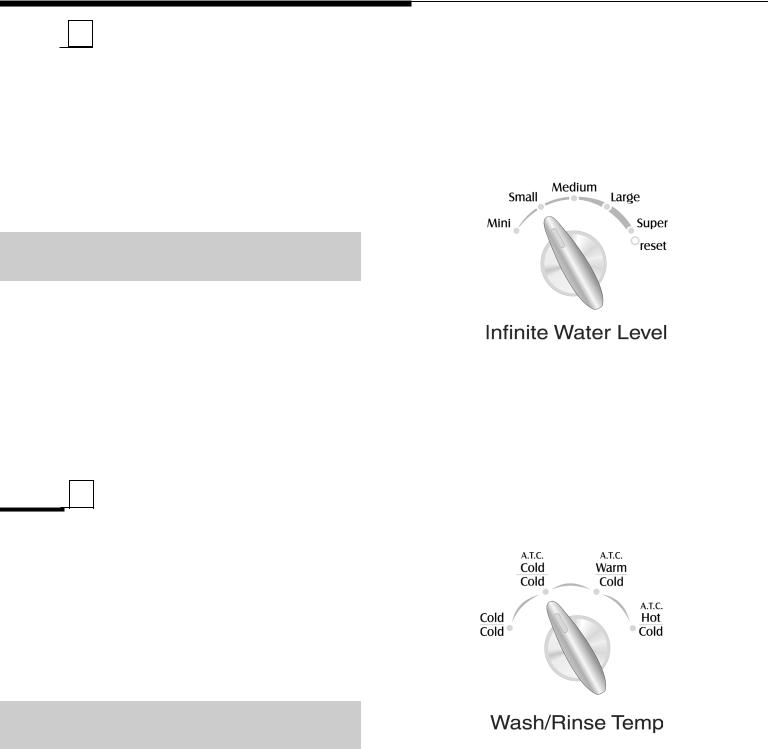
Controls at a Glance
Step 1
Select Water Level
Determine the selected setting based on clothes load size.
On select models, the infinite control allows you to select a specific setting or anywhere in between.
It may become necessary, due to bulky fabrics, to adjust the water level after agitation begins. To adjust the water level, turn the control to RESET and then back to the desired setting.
REMEMBER: Items must circulate freely for best results.
WATER LEVEL SETTING |
LOAD SIZE |
|
|
|
|
|
|
|
Super |
3/4 – Full |
|
|
|
|
Large |
1/2 – 3/4 Full |
|
|
|
|
Medium |
1/3 – 1/2 Full |
|
|
|
|
Small |
1/4 – 1/3 Full |
|
Mini |
1/4 Full |
|
|
|
|
Step 2
Select Wash/Rinse Temperature
Your washer provides you with a choice of hot, warm or cold water for washing and cold water for rinsing.
Automatic Temperature Control (A.T.C.) provides the optimal wash water temperature for cleaning. To save energy, this washer will regulate wash water temperatures by mixing hot and cold water to reach the proper water temperature.
REMEMBER: In wash water temperatures below 60° F, detergents do not dissolve well or clean well.
3

Step |
|
2 |
|
|
|
(continued) |
|
|
||
WASH/RINSE TEMPS |
LOAD TYPE |
|||||||||
|
|
|
|
|
|
|
|
|
|
|
|
|
|
|
|
|
|
|
|
|
|
|
Cold |
|
|
Brightly colored, lightly soiled |
||||||
|
Cold |
|
items; washable woolens. |
|||||||
|
|
|
|
|||||||
These settings feature automatic temperature control. |
||||||||||
|
|
|
|
|
|
|
|
|
||
A.T.C. Cold |
|
Assures cold water wash tem- |
||||||||
|
perature of approximately 65° F |
|||||||||
|
Cold |
|
|
|||||||
|
|
to properly activate detergent. |
||||||||
|
|
|
|
|
|
|
|
|
||
A.T.C. Warm |
Assures warm water wash tem- |
|||||||||
perature of approximately 75° F; |
||||||||||
|
Cold |
|
|
provides optimum cleaning |
||||||
|
|
|
|
|
|
|
|
results. |
|
|
|
|
|
|
|
|
|
|
|
|
|
|
A.T.C. Hot |
|
|
Assures hot water wash temper- |
||||||
|
|
ature of approximately 105° F to |
||||||||
|
Cold |
|
||||||||
|
|
clean white and heavily soiled |
||||||||
|
|
|
|
|
|
|
|
color-fast items. |
||
|
|
|
|
|
|
|
|
|
|
|
Step 3
Select Wash/Spin Speed
Your washer has selectable wash and spin speed combinations.
Control features vary by model.
WASH/SPIN SPEEDS |
LOAD TYPE |
||
|
|
|
|
|
Regular/Whites |
|
Sturdy fabrics needing |
|
maximum water extraction like |
||
|
Normal/Fast |
||
|
jeans, towels, bedding. |
||
|
|
|
|
|
|
|
|
|
Cotton/Colors |
|
Alternating agitation between |
|
fast and slow to care for |
||
|
Medium/Fast |
||
|
clothes with color. |
||
|
|
|
|
|
Perm. Press |
|
Sturdy fabrics needing a slow- |
|
er spin speed to reduce wrin- |
||
|
Normal/Slow |
kling, such as dress shirts and |
|
|
|
|
dress pants. |
|
Sweaters |
|
Slow agitation to gently wash |
|
Gentle/Fast |
sweaters followed by a fast spin |
|
|
(select models) |
to remove moisture. |
|
|
Rugs |
|
Intermittent slow agitation and |
|
Ex. Gentle/Fast |
fast spin to remove moisture |
|
|
(select models) |
from washable throw rugs. |
|
|
Delicate |
|
Delicate fabrics needing |
|
slower spin speed because |
||
|
Gentle/Slow |
||
|
of clothing construction. |
||
|
|
|
|
|
Handwash |
Intermittent slow agitation and |
|
|
soak to gently wash the most |
||
|
|
|
|
|
Ex. Gentle/Slow |
||
|
delicate items. |
||
|
|
|
|
4
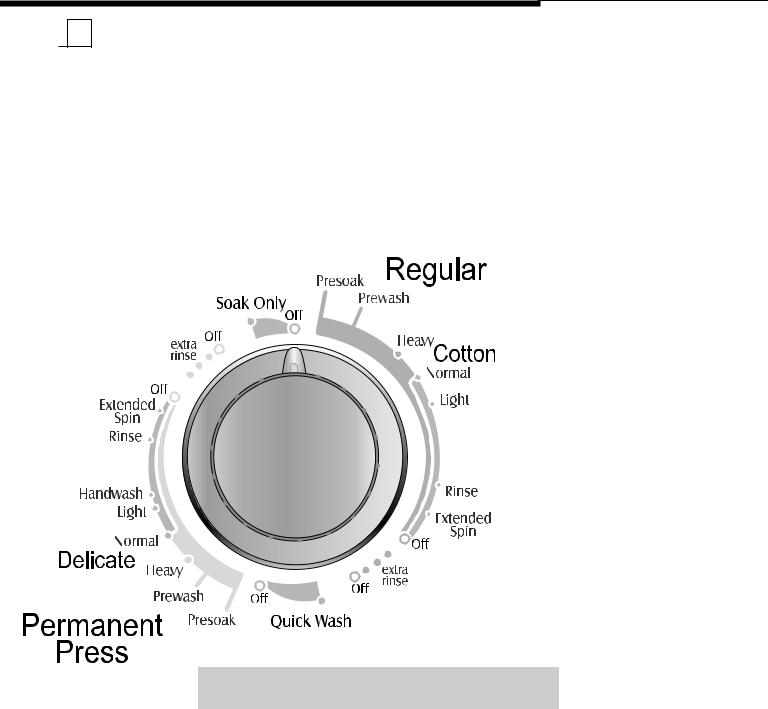
Controls at a Glance (continued)
Step 4
Select a Cycle
Press the control dial in and turn in either direction to the desired cycle. Pull the dial out to start the washer.
Note: All wash times are approximate.
Soak Only: Provides 3 minutes of agitation and then soak. Avoid extended soaking – soak for 30 minutes or less. The control dial must be manually advanced to a spin setting to spin and drain the water.
Regular Cycle
Regular Cycle is designed to clean underwear, T- shirts and other cotton sturdy items like towels, sheets, jeans, etc.
PRESOAK (select models): The washer will agitate for 3 minutes, soak for 6 minutes and then automatically proceed into the next cycle.
PREWASH (select models): 33 minutes of wash time.
HEAVY: 21 minutes of wash time.
Cottons or regular fabrics may be washed using the following settings:
NORMAL: 15 minutes of wash time.
LIGHT: 9 minutes of wash time. The Light Cycle is appropriate for most loads.
EXTENDED SPIN (select models): Provides three extra minutes of spin.
Quick Wash: This cycle is designed to refresh clothing. Quick Wash should only be used for small loads with little to no soil and minimal water level. Use no more than a teaspoon of detergent.
Changes in wash speed are normal. Occasional pauses up to 3 minutes in length are normal.
Permanent Press Cycle
Permanent Press cycle is designed to clean dress shirts, dress pants, business casual and poly/cotton to reduce wrinkling.
PRESOAK (select models): The washer will agitate for 3 minutes, soak for 6 minutes and then automatically proceed into the next cycle.
PREWASH: 27 minutes of wash time.
5
HEAVY: 21 minutes of wash time.
Delicate or Permanent Press fabrics may be washed using the following settings:
NORMAL: 15 minutes of wash time. (This is the recommended setting for most loads.)
LIGHT: 9 minutes of wash time.
HANDWASH (select models): 6 minutes of wash time.
EXTENDED SPIN (select models): Provides three extra minutes of spin.
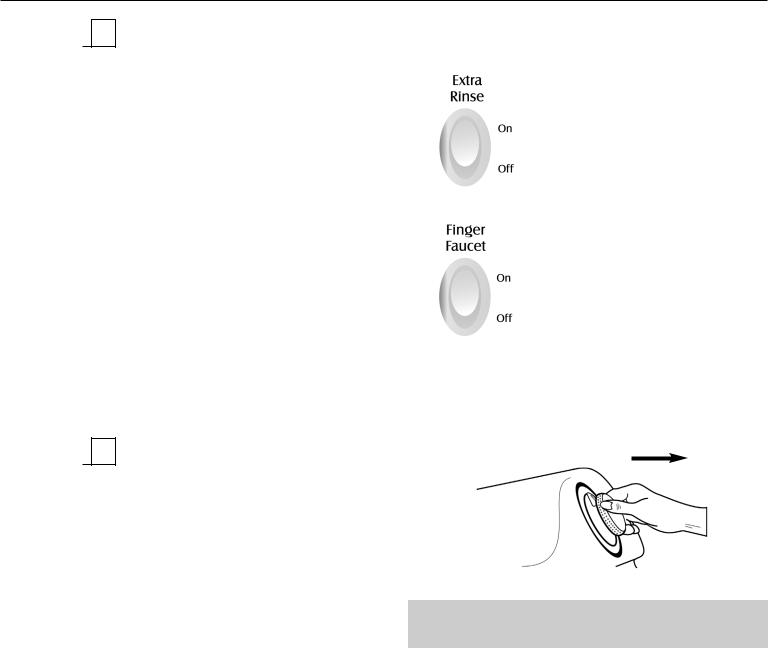
Control features vary by model.
Step 5 (if desired)
Select Options
Extra Rinse (select models):
When the switch is in the “On” position, an extra rinse is added to the end of the cycle to more completely remove laundry additives, suds, perfumes, etc.
Finger Faucet (select models):
Provides a flow of water when the switch is in the “On” position.
•If the selected water level is reached, the finger faucet will not operate.
•For your safety, the finger faucet will not operate if hot wash is selected.
Step 6
Pull Control Dial Out to Start
•Add detergent and any additives.
•Add load and close lid.
•Pull out control knob to start.
You may stop the washer at any time by simply pushing the control dial IN. Therefore, it is possible to obtain a non-agitated soak or to shorten, skip or repeat any part of a cycle. The control dial must be pushed IN (off position) when you change the setting.
For detailed information on sorting, pretreating stains, etc., see the enclosed Laundry Tips booklet.
6
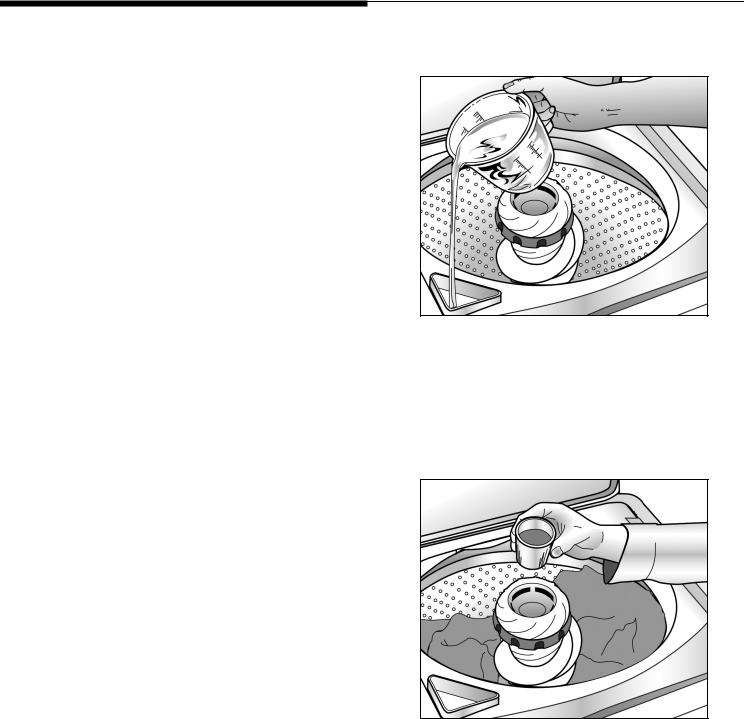
Special Features
Liquid Chlorine
Bleach Dispenser
The dispenser automatically dilutes liquid chlorine bleach before it reaches your wash load. To use, follow these steps:
1.Measure liquid chlorine bleach carefully, following the instructions on the bottle.
2.Add the bleach to the dispenser before adding the load. Avoid splashing or over-filling the dispenser.
NOTE:
•Never pour undiluted liquid chlorine bleach directly onto the load or into the wash tub. It is a powerful chemical and can cause fabric damage, such as tearing or color loss, if not used properly.
•If you prefer to use color-safe, non-chlorine bleach, pour it into the wash tub with your detergent. Do not pour non-chlorine, color-safe bleaches into the bleach dispenser.
Fabric Softener Dispenser
The dispenser automatically releases liquid fabric softener at the proper time during the cycle. To use, follow these steps:
1.Pour liquid fabric softener into the dispenser using the amount recommended on the package.
2.For proper dispensing of fabric softener in the washer, add warm water to the fabric softener in the dispenser until the level reaches the fill line. Wipe up spills.
•Do not stop the washer during the first spin. This will cause the dispenser to empty too soon.
•Never pour fabric softener directly on the load. It will leave spots and stains.
•Use the dispenser for liquid fabric softeners only.
Pour liquid chlorine bleach into bleach dispenser.
Pour fabric softener into softener dispenser.
7
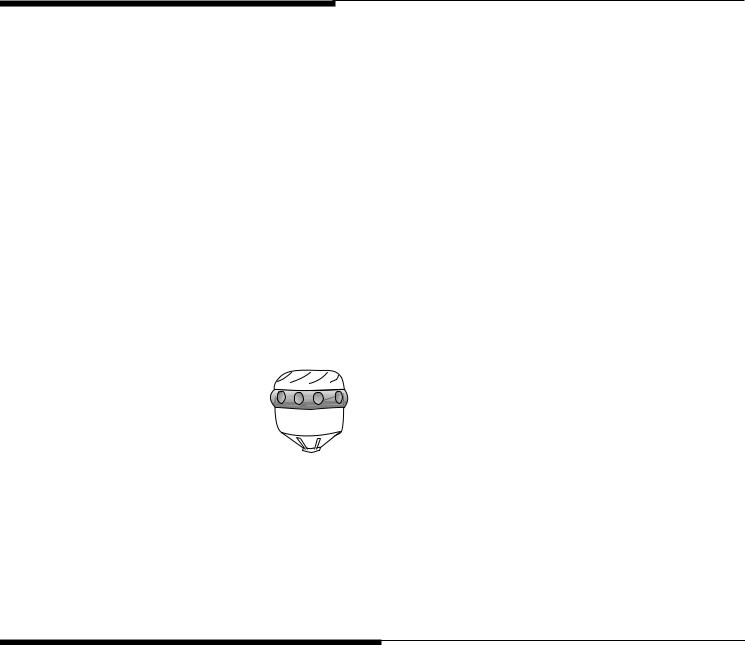
Care & Cleaning
Turn off the water faucets after finishing the day’s washing. This will shut off the water supply to the washer and prevent the unlikely possibility of damage from escaping water.
Use a soft cloth to wipe up all detergent, bleach or other spills as they occur.
Clean the following as recommended:
Control Panel – clean with a soft, damp cloth and glass cleaner. Do not use abrasive powders or cleaning pads.
Cabinet – clean with soap and water.
Fabric Softener Dispenser
1.Pull the dispenser off of the top of the agitator.
2.Soak for one hour in sink or container in hot water and dishwashing liquid.
3.Hold hands over top and bottom of dispenser and shake to loosen buildup.
4.Rinse with clean, hot water.
5. Repeat process if necessary.
6. Replace dispenser on agitator.
Do not use dishwashing liquid inside the washer. Oversudsing can occur.
Storing the Washer
Washers can be damaged if water is not removed from hoses and internal components before storage. Prepare the washer for storage as follows:
•Select NORMAL on the REGULAR cycle and add one cup of bleach OR white vinegar to a full load of water without clothes. (Do not mix bleach and vinegar in the same wash. Hazardous fumes can form.) Run the washer through a complete cycle.
•Turn the water faucets off and disconnect the inlet hoses.
Interior – hard water deposits may be removed, if needed, using a recommended cleaner labeled washer safe.
The interior of the washer should be cleaned periodically to remove dirt, soil, odor or bacteria residue that may remain in the washer as a result of washing clothes. We recommend taking the following steps every 60 to 120 days to clean and freshen your washer interior. The frequency with which the washer should be cleaned and freshened depends on factors such as usage, the amount of dirt, soil or bacteria being run through your washer, or the use of cold water.
To clean and freshen the washer interior:
1.Add a measured amount of chlorine bleach to the bleach dispenser, following package directions for a normal load.
2.Add 1/4 cup of detergent to the tub.
3.Run the washer through a complete cycle
water level
•Disconnect the washer from the electrical supply and leave the washer lid open to let air circulate inside the tub.
•If the washer has been stored in below-freezing temperatures, allow time for the washer to thaw out prior to use.
•After storage, select NORMAL on the REGULAR cycle and run the washer through a complete cycle.
8
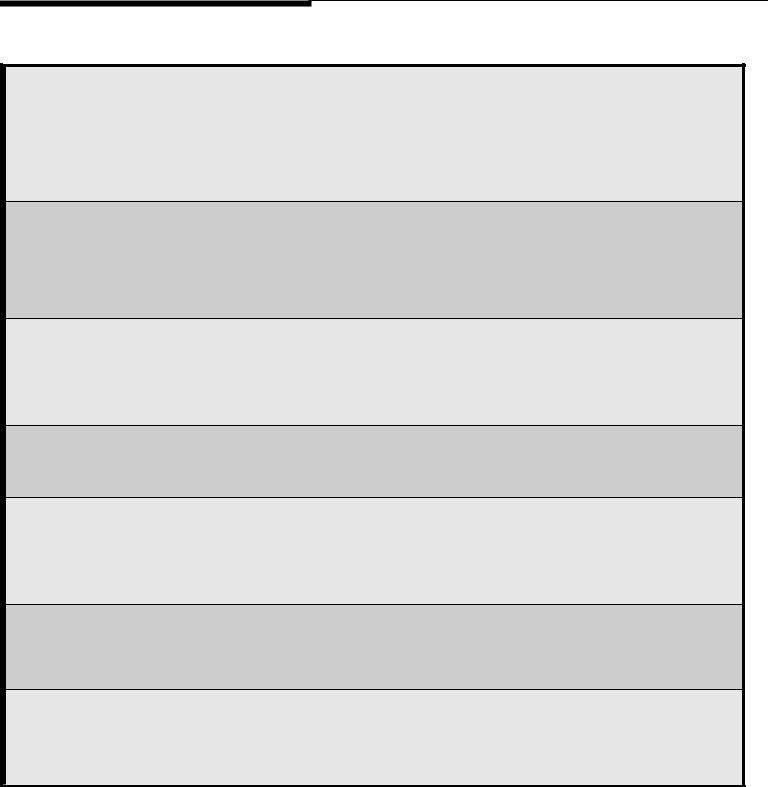
Before You Call
For problem laundry solutions (i.e. fabric damage, residue, tangling) and special laundry care procedures, see the enclosed Laundry Tips brochure.
Won’t Fill
•Plug cord into live electrical outlet.
•Check fuse or reset circuit breaker.
•Turn the control dial to proper cycle and pull dial out to start the washer.
•Turn both faucets on fully.
•Straighten inlet hoses.
•Disconnect hoses and clean screens. Hose filter screens may be plugged at the faucet.
•The drain hose must be elevated at least to the top of the tub.
Won’t Agitate
•Make sure the lid is completely closed.
•Turn the control knob to proper cycle and pull dial out to start the washer.
•Close lid and pull dial out to start the washer. For your safety, washer will not agitate or spin unless the lid is closed.
•The washer is equipped with a lid switch failure detector. If the lid switch should malfunction, the detector will stop operations for your safety. Call for service.
•Pauses are normal. Wait and see if the washer will start again.
Won’t Spin or Drain
•Straighten drain hoses. Eliminate kinked hoses. If there is a drain restriction, call for service.
•Close lid and pull dial out to start the washer. For your safety, washer will not agitate or spin unless the lid is closed.
•The washer is equipped with a lid switch failure detector. If the lid switch should malfunction, the detector will stop operations for your safety. Call for service.
•If the drain height is over eight feet, water may not be completely removed.
Load is Wetter than Normal at the End of the Cycle
•The washer is designed to reduce spin speed if an unbalanced load is detected. This is normal.
•Redistribute the load in the tub and set the washer on SPIN.
•Spin speed may be too slow for load type. Set Wash/Spin speed to Regular/Whites (normal/fast).
Stops
•Turn the control dial to proper cycle and pull dial out to start the washer.
•Close lid and pull dial out to start the washer. For your safety, washer will not agitate or spin unless lid is closed.
•This may be a pause or soak period in the cycle. Wait briefly and it may start.
•The washer is equipped with a lid switch failure detector. If the lid switch should malfunction, the detector will stop fill operations for your safety. Call for service.
Leaks Water
•Make sure water inlet hose connections are tight at faucet and water valve.
•Make sure end of drain hose is correctly inserted and secured to drain facility.
•Avoid extended soaking – soak for 30 minutes or less.
•Avoid overloading.
Is Noisy
•Be sure washer is leveled properly as outlined in installation manual.
•Weak floors can cause vibration and walking.
•Be sure rubber feet are installed on leveling legs.
•Operating sounds will vary depending on agitation speed.
9
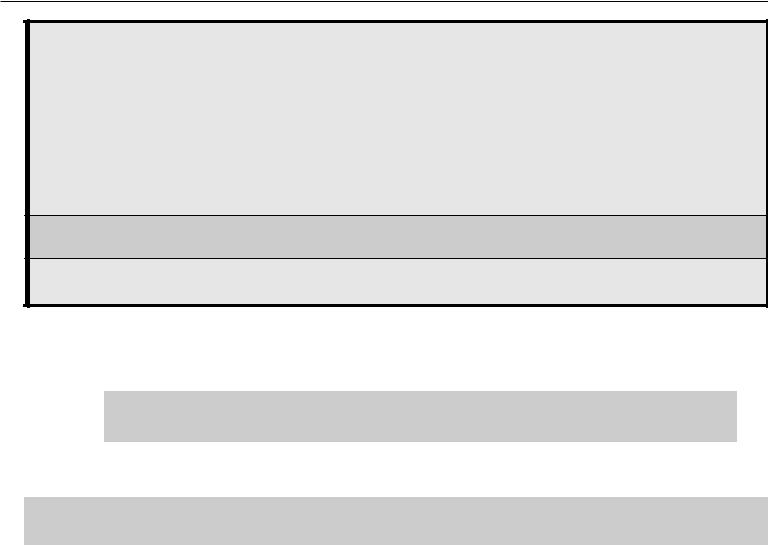
Fills with the Wrong Temperature Water
•Turn both faucets on fully.
•Make sure temperature selection is correct.
•If Auto Temperature Control is selected, cold water may feel warmer than cold water from the tap (see page 3).
•Make sure hoses are connected to correct faucets and inlet connections. Be sure water supply is regulated correctly. Flush water line before filling washer.
•Check the water heater. It should be set to deliver a minimum 120° F (49° C) hot water at the tap. Also check water heater capacity and recovery rate.
•Disconnect hoses and clean screens. Hose filter screens may be plugged.
•To obtain the energy savings, warm water fills are lukewarm.
•To save energy, this washer will regulate wash water temperatures by mixing hot and cold water to reach the proper water temperature.
Cycle Selector Advances Through Off
• Extra rinse is selected.
Finger Faucet Will Not Operate (select models)
• The water level switch has detected a full tub. No more water will be added to prevent the tub from overflowing.
For further assistance contact Maytag ServicesSM, Maytag Customer Assistance: U.S. 1-800-688-9900 or Canada 1-800-688-2002
U.S. customers using TTY for deaf, hearing impaired or speech impaired, call 1-800-688-2080.
NOTE: In our continuing effort to improve the quality of our appliances, it may be necessary to make changes to the appliance without revising this guide.
10
